近两年.Net Core发展的很快,目前最新版为3.0预览版,之前在网上买了一本1.1版书籍都还没来得及看呢,估计现在拿出来看也毫无意义了。已多年.net工作经验,看书不如直接实际上手来得快,遇到问题再度娘吧。正好最近公司不忙时,抽空亲手搭建.Net Core项目熟悉一下,说起.net那最自豪的就是VS编译器了,强大的辅助功能很多中小型项目只需要下一步就可以创建完成。这里我们还需要简单封装一下,使用仓储模式对数据访问层封装和Service层封装,通过.net自带DI依赖注入进行创建对象。对于初学者的我只能简单的封装一下,接下来我会一一讲解框架的思路,如有更好的方案或不明的地方欢迎留言。转载请备注来源:https://www.cnblogs.com/han1982/p/11058788.html
下面是已搭建好的框架结构:
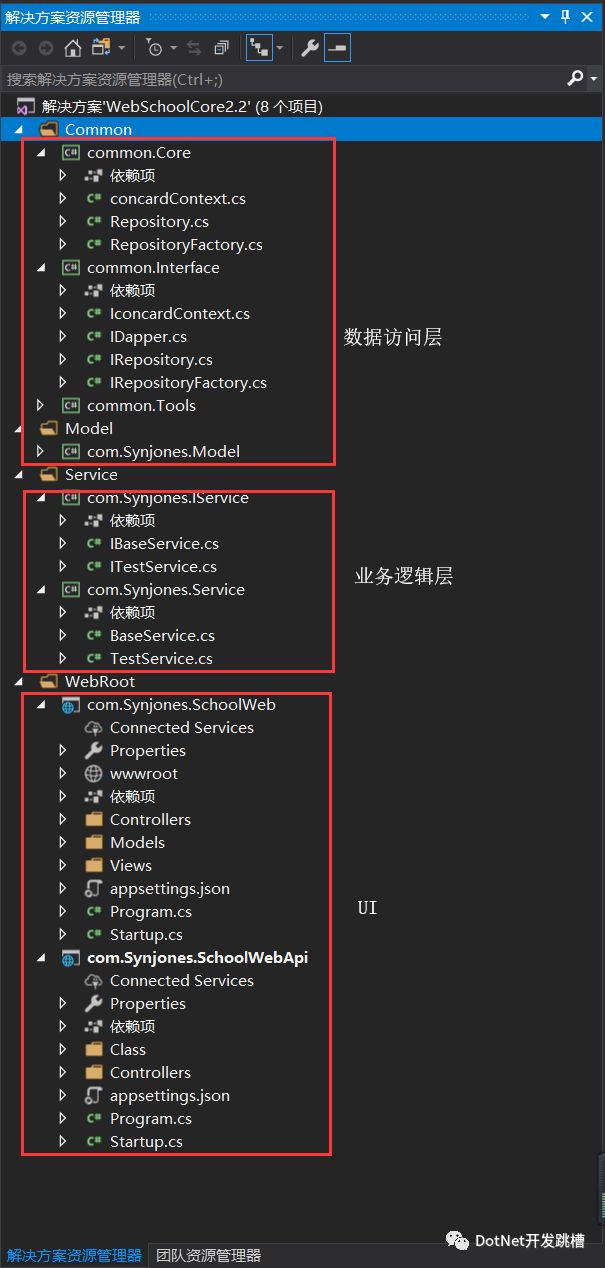
第一步:创建解决方案
使用Visual Studio 2019编译器创建解决方案,默认安装vs2019自带的.NET Core 2.1,创建.NET Core 2.2版需要下载SDK安装。
https://dotnet.microsoft.com/download/visual-studio-sdks?utm_source=getdotnetsdk&utm_medium=referral
接下来可以创建项目了,首先创建的是数据访问层,我们命名为common.Core,另外给他创建一个接口层common.Interface。

(注意所有程序集创建必须为.Net Core版,为以后发布垮平台考虑)
第二步:创建Model层
封装仓储层之前先来创建数据Model层,Nuget添加EF Core相关引用,工具 - NuGet包管理器 - 程序包管理器控制台,默认项目选择Model程序集依次安装以下组件包。
Install-Package Microsoft.EntityFrameworkCore -version 2.2.4
Install-Package Microsoft.EntityFrameworkCore.SqlServer -version 2.2.4
Install-Package Microsoft.EntityFrameworkCore.Tools -version 2.2.4

也可以在项目中找到依赖项,右键管理NuGet管理包方式进行添加。

Microsoft.EntityFrameworkCore.Tools中包含了Microsoft.EntityFrameworkCore.Design依赖包,不需要单独安装了。
这里我使用的是Database First模式,使用工具Scaffold-DbContext(数据库上下文脚手架)来生成model类文件和DbContext。
执行以下命令:-o (OutputDir) 指定用于输出类的目录 -f (Force) 生成时覆盖现有文件 -Context 指定生成的DbContext类的名称,省略的话按数据库名称生成DbContext类文件。
Scaffold-DbContext "server=.;database=ConCard;uid=sa;pwd=123123;" Microsoft.EntityFrameworkCore.SqlServer -O Models -F

出现错误:VS2019有个小小BUG,默认项目选中以后最终执行的不是被选中程序集,这里需要把model程序集设为启动项目,再次执行。
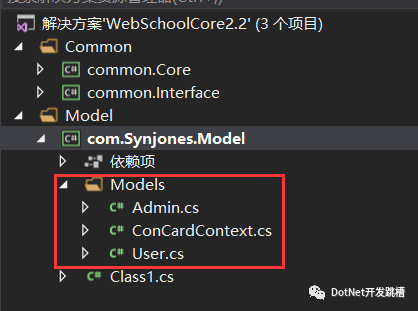
自动生成所有类模型文件,ConCardContext.cs数据库上下文也都帮你创建好了,这样就省去了我们手动写DBSet时间。
第三步:封装数据访问层
数据访问层主要封装仓储Repository和工作单元UnitOfWork,我把这两个合并到一个类中实现,通过简单工厂方式创建实例对象。
我们直接把ConCardContext.cs这个类复制到common.Core程序集中,把命名空间修改为common.Core。
这时应该报错,因为common.Core项目中没有引用EFCore依赖包,按之前Model层添加一样,使用Install-Package命令为common.Core添加依赖包,Tools可以不用安装。

依赖项中,右键添加引用,把Model和common.Interface项目引用,ConCardContext.cs中using model就不会报错了。
接下来修改下ConCardContext:
重写SaveChanges方法
publicoverrideintSaveChanges
{
returnbase.SaveChanges( true);
}
删除OnConfiguring方法,因为我们不需要在这里配置数据库连接,后面通过读取配置方式设置。
protectedoverridevoidOnConfiguring(DbContextOptionsBuilder optionsBuilder)
{
if(! optionsBuilder.IsConfigured)
{
optionsBuilder.UseSqlServer("server=.;database=ConCard;uid=sa;pwd=123123;");
}
}
common.Interface程序集中创建IconcardContext接口,ConCardContext类中继承自这个接口。(主要用来后期使用DI依赖注入使用,不用接口也可以用DbContext代替)
ConCardContext类:
usingSystem;
usingcom.Synjones.Model.Models;
usingcommon.Interface;
usingMicrosoft.EntityFrameworkCore;
usingMicrosoft.EntityFrameworkCore.Metadata;
namespacecommon.Core
{
publicpartialclassConCardContext : DbContext, IconcardContext
{
publicConCardContext
{
}
publicConCardContext(DbContextOptions<ConCardContext> options)
: base(options)
{
}
publicoverrideintSaveChanges
{
returnbase.SaveChanges( true);
}
publicvirtualDbSet<Admin> Admin { get; set; }
publicvirtualDbSet<User> User { get; set; }
protectedoverridevoidOnModelCreating(ModelBuilder modelBuilder)
{
modelBuilder.HasAnnotation("ProductVersion", "2.2.4-servicing-10062");
modelBuilder.Entity<Admin>(entity =>
{
entity.Property(e => e.PassWord).HasMaxLength( 50);
entity.Property(e => e.UserId).HasMaxLength( 50);
});
modelBuilder.Entity<User>(entity =>
{
entity.Property(e => e.Name).HasMaxLength( 50);
entity.Property(e => e.Phone).HasMaxLength( 50);
});
}
}
}
开始继续创建Repository.cs仓储类,它是一个泛型类,并且拥有一个带有参数的构造方法,通过构造方法获得当前DbContext上下文对象,泛型类为指定Model类型,通过DbContext.Set<T>方法最终得到相应的DbSet<T>对象来操作工作单元。
当然我们也要给他定义一个接口IRepository接口:
usingSystem;
usingSystem.Collections.Generic;
usingSystem.Data;
usingSystem.Linq;
usingSystem.Linq.Expressions;
usingSystem.Text;
namespacecommon.Interface
{
publicinterfaceIRepository<T> : IDisposable whereT : class
{
///<summary>
///显式开启数据上下文事务
///</summary>
///<param name="isolationLevel">指定连接的事务锁定行为</param>
voidBeginTransaction(IsolationLevel isolationLevel = IsolationLevel.Unspecified);
///<summary>
///提交事务的更改
///</summary>
voidCommit;
///<summary>
///显式回滚事务,仅在显式开启事务后有用
///</summary>
voidRollback;
///<summary>
///提交当前单元操作的更改
///</summary>
intSaveChanges;
///<summary>
///获取 当前实体类型的查询数据集,数据将使用不跟踪变化的方式来查询,当数据用于展现时,推荐使用此数据集,如果用于新增,更新,删除时,请使用<see cref="TrackEntities"/>数据集
///</summary>
IQueryable<T> Entities { get; }
///<summary>
///获取 当前实体类型的查询数据集,当数据用于新增,更新,删除时,使用此数据集,如果数据用于展现,推荐使用<see cref="Entities"/>数据集
///</summary>
IQueryable<T> TrackEntities { get; }
///<summary>
///插入 - 通过实体对象添加
///</summary>
///<param name="entity">实体对象</param>
///<param name="isSave">是否执行</param>
//////<returns></returns>
T Add(T entity, boolisSave = true);
///<summary>
///批量插入 - 通过实体对象集合添加
///</summary>
///<param name="entitys">实体对象集合</param>
///<param name="isSave">是否执行</param>
voidAddRange(IEnumerable<T> entitys, boolisSave = true);
///<summary>
///删除 - 通过实体对象删除
///</summary>
///<param name="entity">实体对象</param>
///<param name="isSave">是否执行</param>
voidDelete(T entity, boolisSave = true);
///<summary>
///批量删除 - 通过实体对象集合删除
///</summary>
///<param name="entitys">实体对象集合</param>
///<param name="isSave">是否执行</param>
voidDelete( boolisSave = false, paramsT[] entitys);
///<summary>
///删除 - 通过主键ID删除
///</summary>
///<param name="id">主键ID</param>
///<param name="isSave">是否执行</param>
voidDelete( objectid, boolisSave = true);
///<summary>
///批量删除 - 通过条件删除
///</summary>
///<param name="where">过滤条件</param>
///<param name="isSave">是否执行</param>
voidDelete(Expression<Func<T, bool>> @where, boolisSave = true);
///<summary>
///修改 - 通过实体对象修改
///</summary>
///<param name="entity">实体对象</param>
///<param name="isSave"></param>
voidUpdate(T entity, boolisSave = true);
///<summary>
///批量修改 - 通过实体对象集合修改
///</summary>
///<param name="entitys">实体对象集合</param>
///<param name="isSave"></param>
voidUpdate( boolisSave = true, paramsT[] entitys);
///<summary>
///是否满足条件
///</summary>
///<param name="where">过滤条件</param>
///<returns></returns>
boolAny(Expression<Func<T, bool>> @where);
///<summary>
///返回总条数
///</summary>
///<returns></returns>
intCount;
///<summary>
///返回总条数 - 通过条件过滤
///</summary>
///<param name="where">过滤条件</param>
///<returns></returns>
intCount(Expression<Func<T, bool>> @where);
///<summary>
///返回第一条记录
///</summary>
///<param name="where">过滤条件</param>
///<returns></returns>
T FirstOrDefault(Expression<Func<T, bool>> @where);
///<summary>
///返回第一条记录 - 通过条件过滤
///</summary>
///<typeparam name="TOrder">排序约束</typeparam>
///<param name="where">过滤条件</param>
///<param name="order">排序条件</param>
///<param name="isDesc">排序方式</param>
///<returns></returns>
T FirstOrDefault<TOrder>(Expression<Func<T, bool>> @where, Expression<Func<T, TOrder>> order, boolisDesc = false);
///<summary>
///去重查询
///</summary>
///<param name="where">过滤条件</param>
///<returns></returns>
IQueryable<T> Distinct(Expression<Func<T, bool>> @where);
///<summary>
///条件查询
///</summary>
///<param name="where">过滤条件</param>
///<returns></returns>
IQueryable<T> Where(Expression<Func<T, bool>> @where);
///<summary>
///条件查询 - 支持排序
///</summary>
///<typeparam name="TOrder">排序约束</typeparam>
///<param name="where">过滤条件</param>
///<param name="order">排序条件</param>
///<param name="isDesc">排序方式</param>
///<returns></returns>
IQueryable<T> Where<TOrder>(Expression<Func<T, bool>> @where, Expression<Func<T, TOrder>> order, boolisDesc = false);
///<summary>
///条件分页查询 - 支持排序
///</summary>
///<typeparam name="TOrder">排序约束</typeparam>
///<param name="where">过滤条件</param>
///<param name="order">排序条件</param>
///<param name="pageIndex">当前页码</param>
///<param name="pageSize">每页记录条数</param>
///<param name="count">返回总条数</param>
///<param name="isDesc">是否倒序</param>
///<returns></returns>
IEnumerable<T> Where<TOrder>(Func<T, bool> @where, Func<T, TOrder> order, intpageIndex, intpageSize, outintcount, boolisDesc = false);
///<summary>
///条件分页查询 - 支持排序 - 支持Select导航属性查询
///</summary>
///<typeparam name="TOrder">排序约束</typeparam>
///<param name="where">过滤条件</param>
///<param name="order">排序条件</param>
///<param name="pageIndex">当前页码</param>
///<param name="pageSize">每页记录条数</param>
///<param name="count">返回总条数</param>
///<param name="isDesc">是否倒序</param>
///<returns></returns>
IQueryable<T> Where<TOrder>(Expression<Func<T, bool>> @where, Expression<Func<T, TOrder>> order, intpageIndex, intpageSize, outintcount, boolisDesc = false);
///<summary>
///获取所有数据
///</summary>
///<returns></returns>
IQueryable<T> GetAll;
///<summary>
///获取所有数据 - 支持排序
///</summary>
///<typeparam name="TOrder">排序约束</typeparam>
///<param name="order">排序条件</param>
///<param name="isDesc">排序方式</param>
///<returns></returns>
IQueryable<T> GetAll<TOrder>(Expression<Func<T, TOrder>> order, boolisDesc = false);
///<summary>
///根据ID查询
///</summary>
///<typeparam name="Ttype">字段类型</typeparam>
///<param name="id">主键ID</param>
///<returns></returns>
T GetById<Ttype> (Ttype id);
///<summary>
///获取最大值
///</summary>
///<typeparam name="Ttype">字段类型</typeparam>
///<param name="column">字段条件</param>
///<returns></returns>
Ttype Max<Ttype>(Expression<Func<T, Ttype>> column);
///<summary>
///获取最大值
///</summary>
///<typeparam name="Ttype">字段类型</typeparam>
///<param name="column">字段条件</param>
///<param name="where">过滤条件</param>
///<returns></returns>
Ttype Max<Ttype>(Expression<Func<T, Ttype>> column, Expression<Func<T, bool>> @where);
///<summary>
///获取最小值
///</summary>
///<typeparam name="Ttype">字段类型</typeparam>
///<param name="column">字段条件</param>
///<returns></returns>
Ttype Min<Ttype>(Expression<Func<T, Ttype>> column);
///<summary>
///获取最小值
///</summary>
///<typeparam name="Ttype">字段类型</typeparam>
///<param name="column">字段条件</param>
///<param name="where">过滤条件</param>
///<returns></returns>
Ttype Min<Ttype>(Expression<Func<T, Ttype>> column, Expression<Func<T, bool>> @where);
///<summary>
///获取总数
///</summary>
///<typeparam name="TType">字段类型</typeparam>
///<param name="selector">字段条件</param>
///<param name="where">过滤条件</param>
///<returns></returns>
TType Sum<TType>(Expression<Func<T, TType>> selector, Expression<Func<T, bool>> @where) whereTType : new;
}
}
Repository类,实现了CRUD基本功能的封装:
usingcommon.Interface;
usingMicrosoft.EntityFrameworkCore;
usingSystem;
usingSystem.Collections.Generic;
usingSystem.Data;
usingSystem.Data.SqlClient;
usingSystem.Linq;
usingSystem.Linq.Expressions;
usingSystem.Text;
namespacecommon.Core
{
publicclassRepository<T> : IRepository<T> whereT : class
{
privateConCardContext _dbContext;
privatereadonlyDbSet<T> _dbSet;
privatereadonlystring_connStr;
publicRepository(IconcardContext mydbcontext)
{
this._dbContext = mydbcontext asConCardContext;
this._dbSet = _dbContext.Set<T> ;
this._connStr = _dbContext.Database.GetDbConnection.ConnectionString;
}
publicvoidBeginTransaction(IsolationLevel isolationLevel = IsolationLevel.Unspecified)
{
if( this._dbContext.Database.CurrentTransaction == null)
{
this._dbContext.Database.BeginTransaction(isolationLevel);
}
}
publicvoidCommit
{
vartransaction = this._dbContext.Database.CurrentTransaction;
if(transaction != null)
{
try
{
transaction.Commit;
}
catch(Exception)
{
transaction.Rollback;
throw;
}
}
}
publicvoidRollback
{
if( this._dbContext.Database.CurrentTransaction != null)
{
this._dbContext.Database.CurrentTransaction.Rollback;
}
}
publicintSaveChanges
{
returnthis._dbContext.SaveChanges;
}
publicIQueryable<T> Entities
{
get{ returnthis._dbSet.AsNoTracking; }
}
publicIQueryable<T> TrackEntities
{
get{ returnthis._dbSet; }
}
publicT Add(T entity, boolisSave = true)
{
this._dbSet.Add(entity);
if(isSave)
{
this.SaveChanges;
}
returnentity;
}
publicvoidAddRange(IEnumerable<T> entitys, boolisSave = true)
{
this._dbSet.AddRange(entitys);
if(isSave)
{
this.SaveChanges;
}
}
publicvoidDelete(T entity, boolisSave = true)
{
this._dbSet.Remove(entity);
if(isSave)
{
this.SaveChanges;
}
}
publicvoidDelete( boolisSave = true, paramsT[] entitys)
{
this._dbSet.RemoveRange(entitys);
if(isSave)
{
this.SaveChanges;
}
}
publicvoidDelete( objectid, boolisSave = true)
{
this._dbSet.Remove( this._dbSet.Find(id));
if(isSave)
{
this.SaveChanges;
}
}
publicvoidDelete(Expression<Func<T, bool>> @where, boolisSave = true)
{
T[] entitys = this._dbSet.Where<T> (@where).ToArray;
if(entitys.Length > 0)
{
this._dbSet.RemoveRange(entitys);
}
if(isSave)
{
this.SaveChanges;
}
}
publicvoidUpdate(T entity, boolisSave = true)
{
varentry = this._dbContext.Entry(entity);
if(entry.State == EntityState.Detached)
{
entry.State = EntityState.Modified;
}
if(isSave)
{
this.SaveChanges;
}
}
publicvoidUpdate( boolisSave = true, paramsT[] entitys)
{
varentry = this._dbContext.Entry(entitys);
if(entry.State == EntityState.Detached)
{
entry.State = EntityState.Modified;
}
if(isSave)
{
this.SaveChanges;
}
}
publicboolAny(Expression<Func<T, bool>> @where)
{
returnthis._dbSet.AsNoTracking.Any(@where);
}
publicintCount
{
returnthis._dbSet.AsNoTracking.Count;
}
publicintCount(Expression<Func<T, bool>> @where)
{
returnthis._dbSet.AsNoTracking.Count(@where);
}
publicT FirstOrDefault(Expression<Func<T, bool>> @where)
{
returnthis._dbSet.AsNoTracking.FirstOrDefault(@where);
}
publicT FirstOrDefault<TOrder>(Expression<Func<T, bool>> @where, Expression<Func<T, TOrder>> order, boolisDesc = false)
{
if(isDesc)
{
returnthis._dbSet.AsNoTracking.OrderByDescending(order).FirstOrDefault(@where);
}
else
{
returnthis._dbSet.AsNoTracking.OrderBy(order).FirstOrDefault(@where);
}
}
publicIQueryable<T> Distinct(Expression<Func<T, bool>> @where)
{
returnthis._dbSet.AsNoTracking.Where(@where).Distinct;
}
publicIQueryable<T> Where(Expression<Func<T, bool>> @where)
{
returnthis._dbSet.Where(@where);
}
publicIQueryable<T> Where<TOrder>(Expression<Func<T, bool>> @where, Expression<Func<T, TOrder>> order, boolisDesc = false)
{
if(isDesc)
{
returnthis._dbSet.Where(@where).OrderByDescending(order);
}
else
{
returnthis._dbSet.Where(@where).OrderBy(order);
}
}
publicIEnumerable<T> Where<TOrder>(Func<T, bool> @where, Func<T, TOrder> order, intpageIndex, intpageSize, outintcount, boolisDesc = false)
{
count = Count;
if(isDesc)
{
returnthis._dbSet.Where(@where).OrderByDescending(order).Skip((pageIndex - 1) * pageSize).Take(pageSize);
}
else
{
returnthis._dbSet.Where(@where).OrderBy(order).Skip((pageIndex - 1) * pageSize).Take(pageSize);
}
}
publicIQueryable<T> Where<TOrder>(Expression<Func<T, bool>> @where, Expression<Func<T, TOrder>> order, intpageIndex, intpageSize, outintcount, boolisDesc = false)
{
count = Count;
if(isDesc)
{
returnthis._dbSet.Where(@where).OrderByDescending(order).Skip((pageIndex - 1) * pageSize).Take(pageSize);
}
else
{
returnthis._dbSet.Where(@where).OrderBy(order).Skip((pageIndex - 1) * pageSize).Take(pageSize);
}
}
publicIQueryable<T> GetAll
{
returnthis._dbSet.AsNoTracking;
}
publicIQueryable<T> GetAll<TOrder>(Expression<Func<T, TOrder>> order, boolisDesc = false)
{
if(isDesc)
{
returnthis._dbSet.AsNoTracking.OrderByDescending(order);
}
else
{
returnthis._dbSet.AsNoTracking.OrderBy(order);
}
}
publicT GetById<Ttype> (Ttype id)
{
returnthis._dbSet.Find(id);
}
publicTtype Max<Ttype>(Expression<Func<T, Ttype>> column)
{
if( this._dbSet.AsNoTracking.Any)
{
returnthis._dbSet.AsNoTracking.Max<T, Ttype> (column);
}
returndefault(Ttype);
}
publicTtype Max<Ttype>(Expression<Func<T, Ttype>> column, Expression<Func<T, bool>> @where)
{
if( this._dbSet.AsNoTracking.Any(@where))
{
returnthis._dbSet.AsNoTracking.Where(@where).Max<T, Ttype> (column);
}
returndefault(Ttype);
}
publicTtype Min<Ttype>(Expression<Func<T, Ttype>> column)
{
if( this._dbSet.AsNoTracking.Any)
{
returnthis._dbSet.AsNoTracking.Min<T, Ttype> (column);
}
returndefault(Ttype);
}
publicTtype Min<Ttype>(Expression<Func<T, Ttype>> column, Expression<Func<T, bool>> @where)
{
if( this._dbSet.AsNoTracking.Any(@where))
{
returnthis._dbSet.AsNoTracking.Where(@where).Min<T, Ttype> (column);
}
returndefault(Ttype);
}
publicTType Sum<TType>(Expression<Func<T, TType>> selector, Expression<Func<T, bool>> @where) whereTType : new
{
objectresult = 0;
if( newTType.GetType == typeof( decimal))
{
result = this._dbSet.AsNoTracking.Where( where).Sum(selector asExpression<Func<T, decimal>> );
}
if( newTType.GetType == typeof( decimal? ))
{
result = this._dbSet.AsNoTracking.Where( where).Sum(selector asExpression<Func<T, decimal?>> );
}
if( newTType.GetType == typeof( double))
{
result = this._dbSet.AsNoTracking.Where( where).Sum(selector asExpression<Func<T, double>> );
}
if( newTType.GetType == typeof( double? ))
{
result = this._dbSet.AsNoTracking.Where( where).Sum(selector asExpression<Func<T, double?>> );
}
if( newTType.GetType == typeof( float))
{
result = this._dbSet.AsNoTracking.Where( where).Sum(selector asExpression<Func<T, float>> );
}
if( newTType.GetType == typeof( float? ))
{
result = this._dbSet.AsNoTracking.Where( where).Sum(selector asExpression<Func<T, float?>> );
}
if( newTType.GetType == typeof( int))
{
result = this._dbSet.AsNoTracking.Where( where).Sum(selector asExpression<Func<T, int>> );
}
if( newTType.GetType == typeof( int? ))
{
result = this._dbSet.AsNoTracking.Where( where).Sum(selector asExpression<Func<T, int?>> );
}
if( newTType.GetType == typeof( long))
{
result = this._dbSet.AsNoTracking.Where( where).Sum(selector asExpression<Func<T, long>> );
}
if( newTType.GetType == typeof( long? ))
{
result = this._dbSet.AsNoTracking.Where( where).Sum(selector asExpression<Func<T, long?>> );
}
return(TType)result;
}
publicvoidDispose
{
this._dbContext.Dispose;
}
}
}
这样仓储模式就创建好了,接下来想办法通过DI创建实例,而不是直接在Service层new一个实例,但是Repository是泛型类,通过DI创建需要设置,所有不同model类都要声明一遍,这里只能使用简单工厂来处理下。
添加RepositoryFactory类和IRepositoryFactory接口,接口中定义IRepository<T> CreateRepository<T>(IconcardContext mydbcontext) where T : class; 通过实现CreateRepository方法来创建不同数据模型的工作单元。
IRepositoryFactory接口:
usingSystem;
usingSystem.Collections.Generic;
usingSystem.Text;
namespacecommon.Interface
{
publicinterfaceIRepositoryFactory
{
IRepository<T> CreateRepository<T>(IconcardContext mydbcontext) whereT : class;
}
}
RepositoryFactory类:
usingcommon.Interface;
usingSystem;
usingSystem.Collections.Generic;
usingSystem.Text;
namespacecommon.Core
{
publicclassRepositoryFactory : IRepositoryFactory
{
publicIRepository<T> CreateRepository<T>(IconcardContext mydbcontext) whereT : class
{
returnnewRepository<T> (mydbcontext);
}
}
}

第四步:创建Service层:
老规矩,先添加新建项目Service和IService,一个是定义Service接口,另一个是它的实现,他们都需要引入Model层和Interface层,Service要引入IService层。

添加BaseService类和IBaseService接口,接口中定义IRepository<T> CreateService<T> where T : class, new;
IBaseService接口:
usingcommon.Interface;
usingSystem;
usingSystem.Collections.Generic;
usingSystem.Text;
namespacecom.Synjones.IService
{
publicinterfaceIBaseService
{
IRepository<T> CreateService<T> whereT : class, new;
}
}
BaseService类:
usingcom.Synjones.IService;
usingcommon.Interface;
usingSystem;
usingSystem.Collections.Generic;
usingSystem.Text;
namespacecom.Synjones.Service
{
publicclassBaseService : IBaseService
{
privateIRepositoryFactory _repositoryFactory;
privateIconcardContext _mydbcontext;
publicBaseService(IRepositoryFactory repositoryFactory, IconcardContext mydbcontext)
{
this._repositoryFactory = repositoryFactory;
this._mydbcontext = mydbcontext;
}
publicIRepository<T> CreateService<T> whereT : class, new
{
return_repositoryFactory.CreateRepository<T> (_mydbcontext);
}
}
}
这里说明一下,BaseService类也是泛型类,也不需要通过DI方式创建,Service层中根据每个模块添加一个Service类,并且继承BaseService类,DI依赖注入模块Service中直接获取到指定模型的仓储进行操作。
添加User模块UserService类和IUserService接口,UserService类继承父类BaseService,生成构造函数。
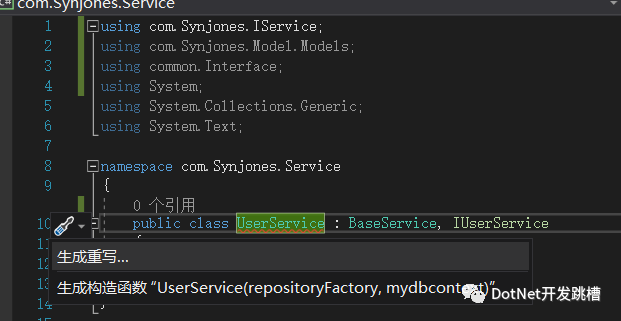
publicUserService(IRepositoryFactory repositoryFactory, IconcardContext mydbcontext) : base(repositoryFactory, mydbcontext)
{
}
下面我们简单举例对user表读取操作的业务层实现,定义接口List<User> GetUsers,实现GetUsers方法,读取所有user表数据。
IUserService接口:
usingcom.Synjones.Model.Models;
usingSystem;
usingSystem.Collections.Generic;
usingSystem.Text;
namespacecom.Synjones.IService
{
publicinterfaceIUserService
{
List<User> GetUsers;
}
}
UserService类:
usingcom.Synjones.IService;
usingcom.Synjones.Model.Models;
usingcommon.Interface;
usingSystem;
usingSystem.Collections.Generic;
usingSystem.Text;
usingSystem.Linq;
namespacecom.Synjones.Service
{
publicclassUserService : BaseService, IUserService
{
publicUserService(IRepositoryFactory repositoryFactory, IconcardContext mydbcontext) : base(repositoryFactory, mydbcontext)
{
}
publicList<User> GetUsers
{
varservice = this.CreateService<User> ;
returnservice.GetAll.ToList;
}
}
}
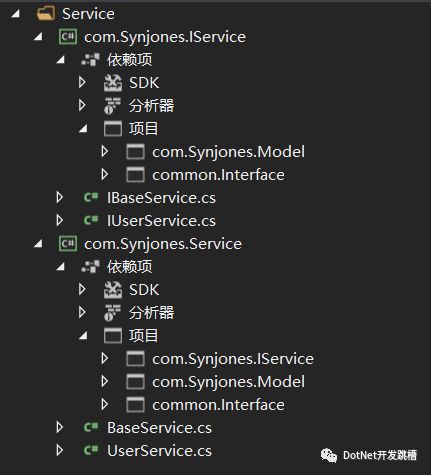
第五步:UI创建并调用Service接口返回数据。
我这里创建了WebApi项目,依赖项中添加引用所有其他项目。
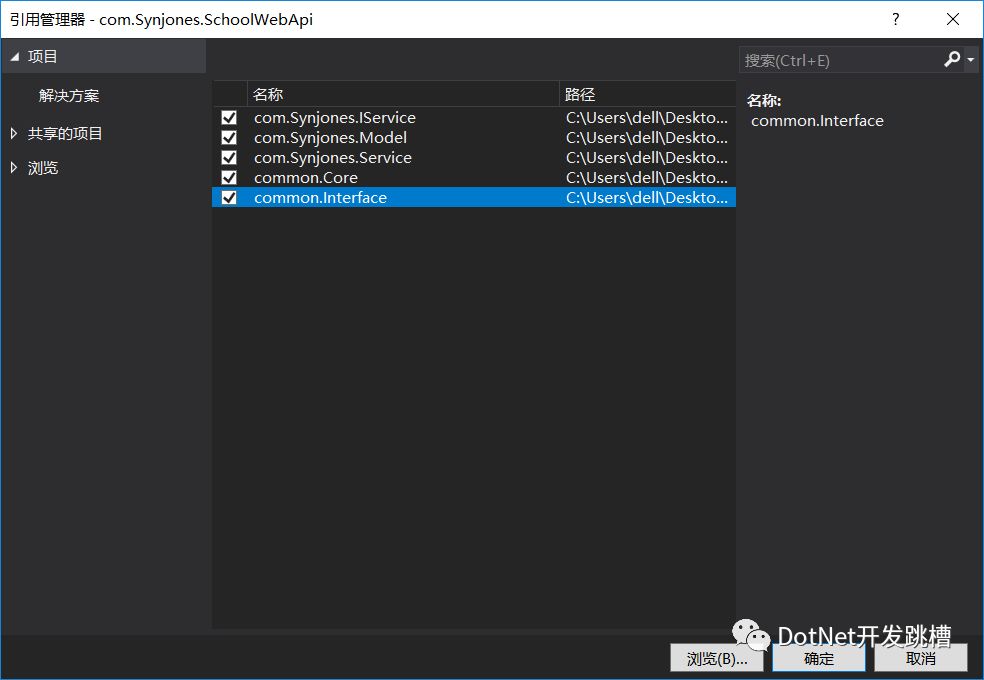
配置数据库连接字符串,打开appsettings.json,添加
"ConnectionStrings": {
"SchoolConnection": "server=.;database=ConCard;uid=sa;pwd=123123;"
}
配置EF服务注册:
打开Startup.cs,ConfigureServices方法中添加services.AddDbContext指定数据库连接配置项,通过services.AddScoped添加DI依赖注入配置。
publicvoidConfigureServices(IServiceCollection services)
{
services.AddMvc.SetCompatibilityVersion(CompatibilityVersion.Version_2_2);
//配置EF服务注册
services.AddDbContext<common.Core.ConCardContext>(options =>
options.UseSqlServer(Configuration.GetConnectionString("SchoolConnection")));
services.AddScoped<IconcardContext, common.Core.ConCardContext> ;
services.AddScoped<IRepositoryFactory, RepositoryFactory> ;
services.AddScoped<IUserService, UserService> ;
}
修改下ValuesController控制器,添加构造函数和Get方法。

WebApi项目设为启动项目,运行看结果。